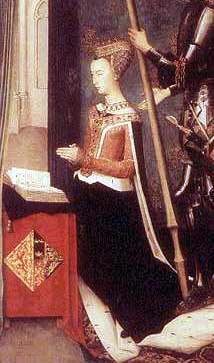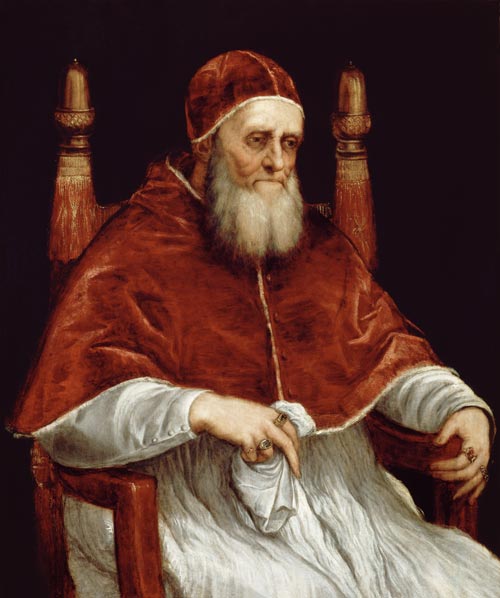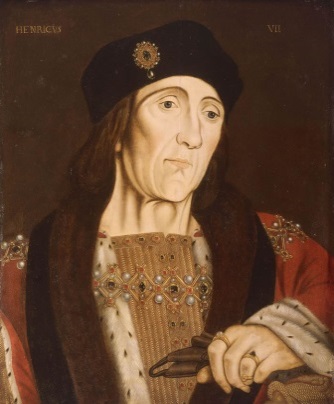James IV
James IV was the eldest son of James III and Margaret of Denmark. Born at Stirling in 1473, he was brought up largely by his mother, a woman of considerable strength of character, far more popular than her husband.

By 1488, with his Queen dead, and his son estranged, James III was facing rebellion. Prince James had joined the rebels, and, on 11 th June, at the Battle of Sauchieburn, near Stirling, the king was defeated and killed, and his son proclaimed as James IV. The new king was crowned at Scone within days.

James never entirely forgave himself for the rebellion which had led to his father's untimely death, and wore an iron belt as a sign of penance for the rest of his life.
Whatever the guilt he may have felt, James put his new found power to good use. He increased Crown revenues to an unheard of level, extended the reach and effectiveness of Royal justice, incorporated the Highlands and Islands into the Kingdom of Scotland for the first time and balanced the power of the competing nobles.
He was eager to create a strong, well-defended kingdom, and copy the trend for increased centralisation of power in the hands of the Crown that had already been embarked on in the rest of Europe.
With this greater strength of the Crown, James was able to enhance Scotland's military and naval power, economic potential and standing in foreign affairs. In particular, James took a keen interest in his navy, commissioning the two largest European ships afloat in the first two decades of the sixteenth century – the Michael and the Margaret.
His ambition throughout was to have Scotland recognised by all of Europe as an independent state and to throw off any vestige of a hint that Scotland's King might be a vassal of England's, a posture that Scottish kings had to resist, often indulging in low level incursions across the Border that were designed to annoy, whilst not provoking their larger neighbour into outright war.

James increased his prestige during the 1490s and early 1500s through judicious management of foreign alliances and the successful (although unpopular) Treaty of Perpetual Peace with England, which came about after an effective campaign in support of the English pretender, Perkin Warbeck.
Scotland thus became a recognised force in European politics for the first time, being courted by Spain and the Pope as well as France. The Pope, Julius II, in hopes of detaching James from the Auld Alliance sent him a very handsome purple velvet cap of maintenance and sword in 1507, which he accepted with thanks and a generous present of £700 to the Pope's ambassador.

His mark made on the European stage, James was free to spend his time on other things. He busied himself with architectural projects, such as the building of the Great Hall at Stirling Castle and the transformation of Falkland and Linlithgow into Renaissance palaces.
James was an indefatigable traveller – he rushed hither and thither around the country, by ship, and horse, as well as on foot in his many pilgrimages. He had a wide range of intellectual interests, even practising dentistry – paying people to allow him to extract teeth! He also had a busy private life with numerous unnamed lovers and four mistresses by whom he had a number of illegitimate children.

The Treaty of Perpetual Peace, cemented by the marriage of James IV and Margaret, daughter of Henry VII of England, had aimed to deal with the constant low-level lawlessness of the Borders and included provisions for redress that each king could expect if the behaviour of the Reivers became too outrageous. Provided the relevant king handed over any miscreant for proper punishment, incursion into the other realm would not be considered an act of aggression. Throughout the remainder of Henry VII's reign, the terms worked reasonably well.

This changed with the accession of Queen Margaret's brother as Henry VIII. Henry VIII was more aggressive than his father. Although the Treaty of Perpetual Peace was renewed in 1509, it soon became evident that Henry was not interested in maintaining good relations with his sister's husband. In a range of matters he failed to give the redress required by the treaty. He also withheld a legacy left to Queen Margaret. Most worrying of all, he encouraged insulting statements in the English Parliament about James being his vassal.
In June 1513, Henry VIII set out to invade France and James was in a cleft stick as he had an alliance with both countries. King Louis XII pressed James to attack England, sending 50,000 French Crowns to fund an invasion. Despite the misgivings of some of his nobles and according to later stories, Queen Margaret begging him to desist, James invaded England in support of his obligations to France.

For the third time James was heading over the border – this time with an army reckoned at some 42,000 men, the largest ever raised in Scotland. Norham Castle fell in 6 days, followed by Wark, Etal and Ford.
James' opponent on the final battlefield was the Earl of Surrey. In a combination of skilled generalship by Surrey and James' determination to press his early victory home, rather than quitting whilst ahead, the enormous Scots army, well equipped and with the odds strongly in its favour, was decimated. James and many of his leading nobles were slaughtered on the field.

James' body was taken to Berwick before being transported to Sheen Priory near London.
Since he had been excommunicated, there was difficulty over his burial, and although Henry VIII received permission from the Pope, no funeral was ever carried out. The remains were left in a store-room at Sheen for over fifty years. Allegedly, the head was eventually buried at the Church of St Michael at Wood Street, London.
James was one of Scotland's most successful kings – he united his country, enforced the rule of law, and showed that Scotland could take its place with pride on the European stage. The tragedy of Flodden and the chaos that the country was plunged into after his death have overshadowed his achievements. A charismatic, courageous and intelligent man, he deserves to be better remembered.
James IV
Family Tree

